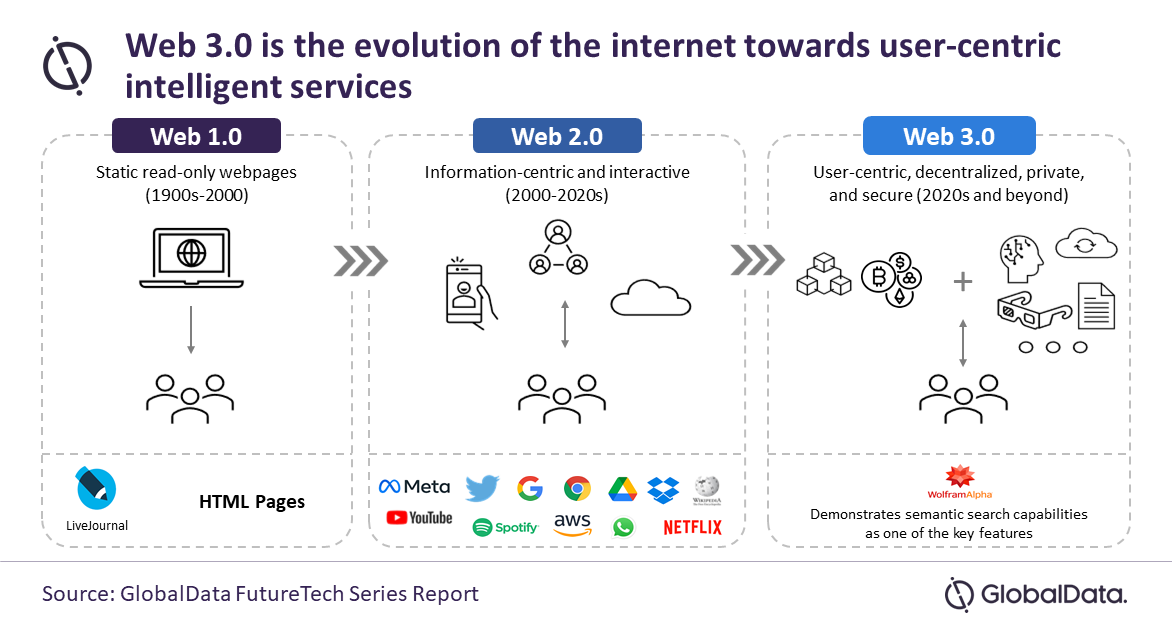The next generation of the internet, known as Web 3.0, has been a topic of conversation among techies. The word encompasses a wide range of cutting-edge concepts that aim to end the monopoly of major technology firms over the internet. While many are hopeful about what Web 3.0 may bring to the table, others are more cautious.
Evolution Of Web 3.0

Web 1.0: 1990-2000 is considered the first Web generation. Syntactic web or read-only webWeb 1.0 was largely about finding and accessing online content. Participation and content production were lacking. AOL, CompuServe, early Yahoo, and others quickly dominated a chaotic scene. These ISPs launched the contemporary Internet.
Web 2.0: The world wide web is interactive and user-friendly (mid-2000s). Read-write/Social Web. Users might publish content to social networks, blogs, etc. Google and Facebook’s user-generated content revolutionised media, advertising, and shopping. Web 2.0 emphasises user engagement to provide new content and marketable data.
Web 3.0 is still in development. Because AI systems can do so much, the internet might become smarter or be able to analyse data at the same level of intelligence as humans.
Web 3.0
In the future generation of the internet, known as Web 3.0, blockchain technology will power all of the services. A public blockchain, which is also utilised for bitcoin transactions, powers this decentralised internet.
Web 3.0 envisions a world where users have full access to and ownership of their personal data and can seamlessly switch between various online services (such as social media, email, and retail) while maintaining a consistent online identity and creating a public ledger of their activities (via blockchain technology) across all of these different platforms.
In the current version of the internet, Web 2.0, most data is stored in central locations. In the next version, all data will be networked in a decentralised way.
The ubiquitous nature of the Internet, the Semantic Web, artificial intelligence, and 3D graphics are all hallmarks of Web 3.0. Illustrations for Web 3.0Not fungible tokens (NFTs) are the most current manifestation of Web 3.0.
Exactly why do we require Web 3.0?
Compromised personal space: The data produced by users’ searches, purchases, and media uploads is currently enormous. All of this information is kept in the databases of the businesses with whom these individuals engage. In this model, intermediaries act as data custodians and derive revenue from targeted advertising based on user information. The more time users spend contributing content, the more information the corporation has to refine its artificial intelligence algorithm and its advertising engine.
Data ownership: For the time being, only centralised repositories may claim ownership of user data and reap the benefits of doing so. Users will have greater control over their information and time in Web 3.0.
Plagiarism: The Internet has become a breeding ground for plagiarists. It’s simple to replicate success on social media by sharing copied content. Some people who steal stuff get paid far more than the person who created the original. Because of plagiarism, it is more difficult for original creators to get paid fairly for their work. It’s possible that Web 3.0 could solve the problem. Blockchain’s open architecture makes it simple to trace information back to its original creator.
What does Web 3.0 mean for the future?
Choice over personal data: In Web 3.0, decentralised blockchain technology will be used to store information rather than centralised databases owned by large enterprises. This means that individuals may now freely decide with which advertisers they wish to share their data with.
Repercussions for Big Tech: With the rise of Web 3.0, even the most established IT firms will be compelled to reevaluate their foundational business strategies and embrace a more community-centric focus. Aspects of this new technology are already being tested by the largest IT companies.
The new regulatory environment: Web 3.0 regulation demands fresh thinking. Authoritarian governments may grab emerging technologies and eliminate private competition. China studied digital money in 2014. It wants exclusive usage at the cost of privacy, freedom, and political opposition.

Where is India in Web 3.0?
Due to the novelty of the concept in India, its growth would be gradual. Biconomy, EPNS, Persistence, and Vauld are just a few of the Indian start-ups that are laying the groundwork for the widespread adoption of Web 3.0. Recently, Polygon’s valuation surpassed $10 billion, and the Indian version of tik tok, Chingari, shifted to blockchain technology.
Even Web 3.0 will have its flaws. Capturing communities, insufficient grievance resolution, illicit usage, and the introduction of fraudulent actors are all possible outcomes. Thus, government intervention is required. Governments must thus recognise the potential of Web 3.0 to empower startups, small digital enterprises, and consumers, and work to create an enabling environment to enable these groups to achieve this promise.













